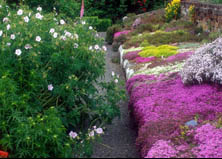The Walled Garden in winter

For the last week we have had nightly frosts and mornings bright with hoar outlining every twig, stem and seedhead. I open the heavy wooden door onto a magical world, mysterious and altered, silent and unmoving except for the birds clustering around the feeder. I kick up some of the frozen leaf litter, turning it over for the robins and blackbirds to find food; bramblings scratch about amongst the drier leaves under the tall beech trees. With the strange distorted shapes of tender shrubs under white fleece, it's a bit like Miss Haversham's dining room. This picture of the espalier trees in the misty light conveys some of that atmosphere. It's a moment in the garden that the public never see.
With no work possible, we had a walk by the river today to see if we could spot the otter again. A few days ago, it was there, its presence given away by the goosanders flying off and then by ripples ebbing out from the bank, dark semi-circles against the bright, pale water reflecting the late afternoon sky. We saw its smooth back as it curved out of the river for a moment, sleek with water before a long line of bubbles showed it swimming away across to the far bank. Today there was no otter, just two dippers bobbing together before diving into the freezing rapids to feed, and a lone goldeneye. We did see an odd sight though; two large salmon simultaneously leaping out of the water and virtually walking on their tails like dolphins for some ten feet before flopping back in again - was it a pike or an otter that had made them do this? I'd never seen that before.
The frosty weather looks set to continue and I am glad that I have the garden well put to bed, perennials cut down, dahlias and cardoons protected by a thick layer of straw and the borders looking amazingly tidy. We'll just have to wait and see if all the plants survive, having not had such a cold spell for several winters. It's a lovely time though for winter walks and I am enjoying what feels like a 'proper winter'.
























